- Allow a user to content swap between two select sites (provide several pre-set options and then swap headlines/content/images)
- A new chair icon placed at the user’s choice in a designated space for the number of people “sitting in a room with you” –> virtual copresence, dibs on your spot.
- Dense grid of “lights” like an LED grid –> clicking on a spot turns it on and off, creates a rudimentary pixelated image.
- Fully develop 7.Interact (bug fixes)
Author Archives: Kate M.
7. Interact – At Least One
Project link: https://katemilleker.github.io/arts445project7/
Project code: https://github.com/katemilleker/arts445project7/blob/master/index.html
Social media post: https://twitter.com/katnicmil/status/983457293827215361
- Kate and Jess
Project 7 Ideas
- Display the difference in time between the time you’ve spent on the page and the time the person who’s been on the page the longest has been on the page. Changes once that oldest person leaves, so eventually the time difference would be 0sec if you became the oldest person. –> place in line.
- You have your own slider (like for volume — 1-100 scale) and you get a celebratory notification if your spot on the slider is the same as your partner’s spot on the slider.
- A new chair icon placed at the user’s choice in a designated space for the number of people “sitting in a room with you” –> virtual copresence, dibs on your spot.
- “Warmer/colder search” like Marco Polo –> color changes from red to blue shades as your position in a circle moves closer to another person’s position. Hide and seek to the mystery location of your partner.
- Dense grid of “lights” like an LED grid –> clicking on a spot turns it on and off, creates a rudimentary pixelated image.
- Light increases brightness/radius with the more people who join a page –> would hit max diameter before max opacity. Every person who enters the space brings their own “candle”.
Changes to Social Media
- Actual control over the content we see – technically we can choose who we follow and what we like, but there’s so much junk overflow we haven’t opted into from platform suggestions, rehash of friend’s activity.
- Following from choosing the content we want to see, less advertisements. We’d be open to paying for content if it meant we would stop being barraged with advertisements that don’t apply to me or that we don’t care about.
- Stigmas/social practices about content creation. There’s pressure to post a certain type of image at a certain frequency, and deviating from that results in a social faux pas and criticism. There’s a reward system for creating content within the defined parameters of the system.
- Changes to the user interface that disrupt the experience of the user rather than enhance or streamline it. This often results in the (extremely irritating) derision from the higher social media powers that be where they know better than us silly, complaining children.
- Educating users on what’s being done with their data, along with more thorough examples and tutorials for security settings.
- Even though its technically the property of each company, we’d love to know how the algorithms work behind the scenes.
- Kate and Jess
Observation 4/2

Occasionally when I’m reading an article through the Facebook app, a spam popup appears and locks up the screen unless I hit “OK”. The only way to get rid of it is to close out and restart the app entirely because some instinct inside me just knows that clicking OK would invite disaster into my phone. I got one this past week and started wondering, “Where do these popups come from? Doesn’t Apple have super-tight security against malware and spam?” So I started doing some research.
“What enables these ad redirects to haunt virtually any browser or app at any time, rather than just the sketchy backwaters in which they used to roam? Third-party ad servers that either don’t vet ad submissions properly for the JavaScript components that could cause redirects, or get duped by innocent-looking ads that hide their sketchy code…Publishers are particularly vulnerable, because they often rely on third-party ad networks for revenue. As a result, they can find themselves at the mercy of whatever a given ad network doles out. Even if publishers use only reputable services, those ad networks can themselves get duped.”
The biggest mistake people make with technology is assuming that it works the way that you think it does. For example, publishers assuming that third party publishers have properly vetted their content or the ad networks assuming their JS code doesn’t have a secondary, malicious purpose. There’s a lot of potential for these spam popups to cause real damage to mobile devices that likely don’t have any anti-malware programs installed. If companies don’t start regulating the content they provide on their platform then this poses a huge potential security risk to users.
In summary:
- No surprise: they’re pretty bad. The notifications are all either marketing tricks or outright scams, and you may be giving the scammers access to your Facebook page. Redirecting ads can do different types of things—some of them are just a nuisance, but redirecting ads can also drop malware on people’s machines.
- Ways to fix it: Ad purchasers are not well-vetted enough and are given too much leeway with regards to JavaScript code execution. Ad exchanges should crack down on this type of aggressive code with a better screening process.
- An ad hijacking your browser like that isn’t technically a hack, in the sense that it doesn’t exploit a software vulnerability. Instead, it relies on the attacker’s ability to submit and run ads that contain redirecting JavaScript. But though they aren’t a critical threat to web users yet, redirecting mobile ads could create a jumping off point for attackers.
An informative article from Wired in January 2018 (quoted above): link
Project #6: Mash
Observe 3/12


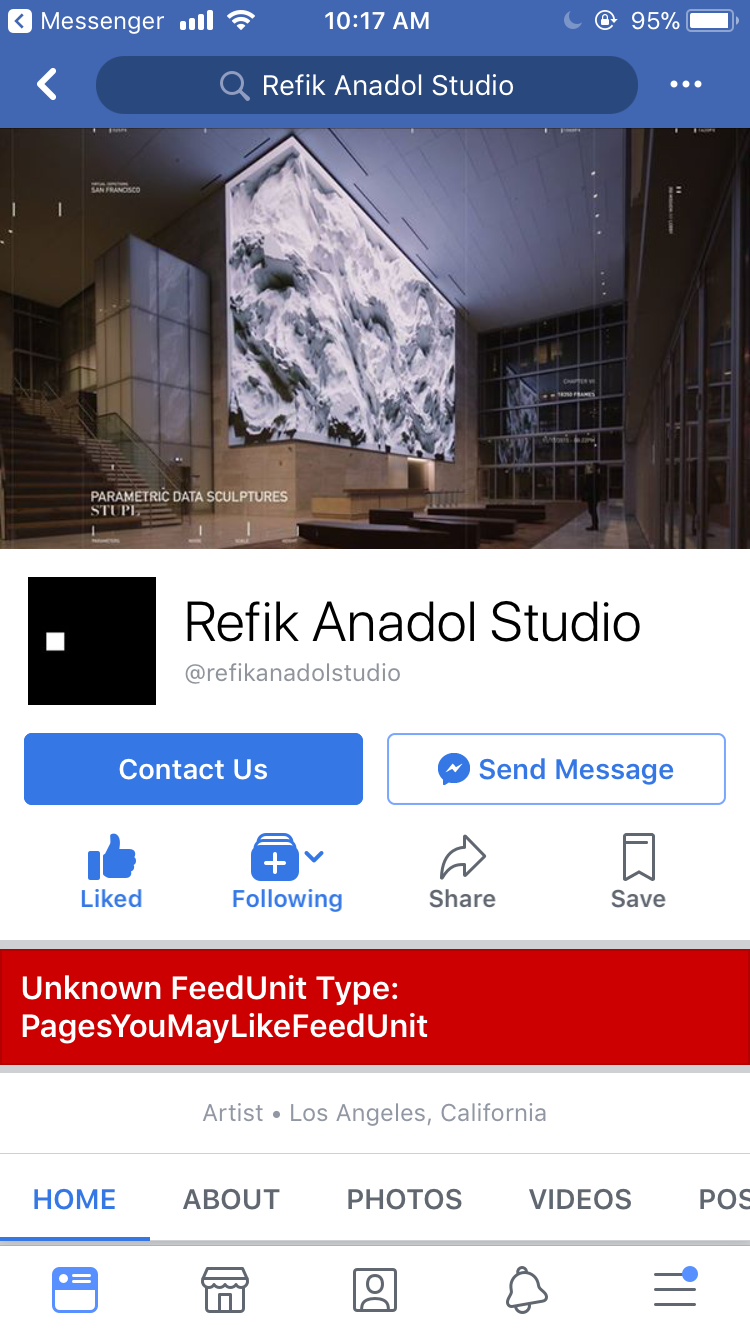

I didn’t have any specific or intentional observation for this week, so here’s a selection of “weird things I noticed on Facebook”:
- Why is my concert event automatically flagged as a job application? What is Facebook parsing from my event to come up with this flag? Can other people see this or is it just because I’m an admin?
- Apparently you can save pictures from someone’s profile, just not their cover photo. Good thing I can tell someone I don’t like their abstract image though.
- Liking a page gave me a weird red error a couple times one day. What’s that about? Facebook get it together.
- I’m very glad I can turn off this feature (and also, what a weirdly specific feature to be able to turn off). The less I interact with ads on Facebook the better.
5. Replace: Hypertext Magnifies Language


For my project, I created a Chrome extension that takes every H, T, M, and L that can be (reasonably) pulled from a web page, capitalizes it, and makes it the color green. I chose to emphasize these letters to pay tribute to the HTML behind the web page. I decided to only change the <p>, <h1…6>, <ul>, <li>, and <table> tags; trying to mess with all <div> or <span> tags, even though they might hold text, seriously impacts the performance of your browser.
I tried for a long time to turn every word in a paragraph tag into a hyperlink for that word, but that ended up being pretty complicated. Changing the source HTML without regards to what anomalies are actually underneath will mess with the DOM in unpredictable ways. For example, if someone is using WordPress and has an <img> tag inside their <p> tag….the internet is an unstandardized lawless wasteland. I saved my algorithm for parsing the words from a <p> tag and I’ll probably try it again for a future project. Everything ended up working out because along the way I learned how to use RegExp (regular expressions) for JavaScript which made my current project pretty easy.

It’s a little frustrating that I wrote so many lines of code to only end up with a 4-line function for my finished project, but it just be like that sometimes.
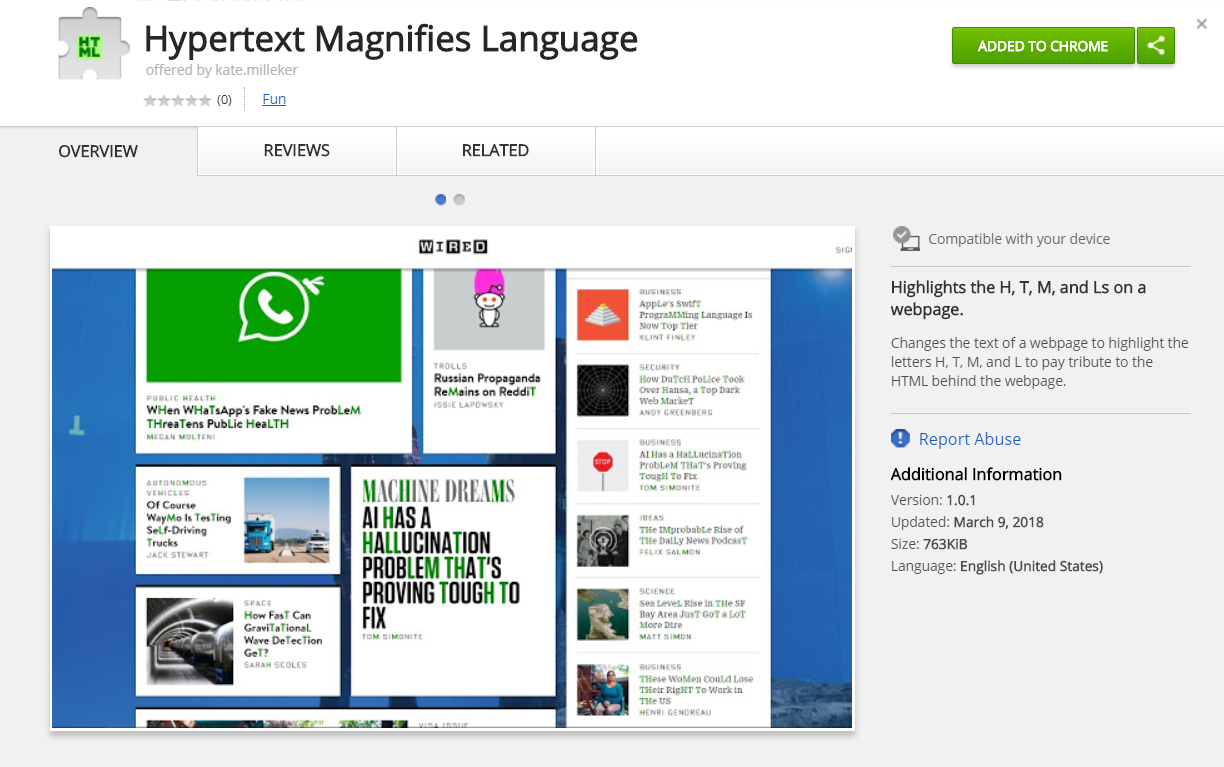
Check out the project on the Chrome Web Store here: link
Project 5: Replace Ideas
- Replace teen vogue with wired articles/images/technology etc
- Replace text color from black to colored –> synesthesia simulator
- Replace friend/follower/likes with that count rounded up or down
- Continuing that, replace all numbers with satisfying even numbers
- Replace words with hyperlinks (not a super fleshed out idea, but I like the idea of introducing hyperlinks to google searches of that word or something similar)
- Taking “hypertext” to mean as much text as possible, is every word a “Feeling Lucky” search, etc.
- Replace “likes” with “didn’t like” (similar to youtube’s “didn’t view”)
- Replace academic or scientific texts with comic sans or non-professional font
- Replace depressing or serious news images with kittens and puppies
Observation 3/5




This week I noticed that Spotify has started adding animated album cover artwork to play during select songs. I knew that “Sign” by VHS Collection utilized this, but I realized this week that another song — “List of Demands” by The Kills — was doing it as well. This doesn’t seem to be a default setting for a song, and it appears that the artist has to choose to create and upload it. It also doesn’t necessary apply to the whole album; for The Kills’ artwork, the animation didn’t appear for any other song on that album (the VHS song was just a single so I couldn’t tell with that one). You can tell if a song has animated artwork by seeing the green circled icon on the “Now Playing” bar on the bottom of the Spotify app (see below on the left). When you pull up the “Playing From” screen after clicking on the bottom bar, the screen changes from the typical album display (see below on the right) to the full-screen animation (see above on the left). If you click on the animation it shows the song information with the animation dimmed and playing behind it (see above on the right), but this only stays active for a few seconds before reverting back to the animation. It clearly puts the animation front and center for the user.


I would love to see more of these types of animations from Spotify. I think it’s a really unique, eye-catching way of displaying music. It makes me feel more engaged and interested in the song that is playing. I don’t usually leave my phone on display when listening to music but I would probably start doing it if it meant seeing album art like this in a cool new way. I’m surprised more artists don’t do this for their music or why they don’t do it for the whole album. It seems like a very innovative way to incorporate music with the technology behind the streaming service.
Also, I like how much Spotify encourages you to share your screenshots with your friends. I got the blue notification every time I took a screenshot for this post.
4. Remove Sources
// ==UserScript==
// @name Source Remover
// @version 1.0
// @namespace source-remover
// @description Alters the NYT by removing all authors, credits, reference links, footnotes
// @require http://arts445.courses.bengrosser.com/files/ready-vanilla.js
// @require http://code.jquery.com/jquery-3.3.1.min.js
// @run-at document-start
//
// @match *://*.nytimes.com/*
// @include *://*.nytimes.com/*
// @exclude *://*.nytimes.com/ai.php*
// @exclude *://*.nytimes.com/ajax/*
// @exclude *://*.nytimes.com/dialog/*
// @exclude *://*.nytimes.com/connect/*
// ==/UserScript==// -----------------------------------------
(function() {
var j;
function main() {
j = jQuery.noConflict();
j('.credit, .byline, .story-footer, .caption-text').each(function() { hideElement(this); });
j('.story-body img, .story-interrupter img').each(function() { hideElement(this); });
j('.story-body a').each(function() { hideElement(this); });
j('time').each(function() { hideElement(this); });
ready('.credit, .byline, .story-footer, .caption-text', function(e) { hideElement(e); });
ready('.story-body img, .story-interrupter img', function(e) { hideElement(e); });
ready('.story-body a', function(e) { hideElement(e); });
ready('time', function(e) { hideElement(e); });
function hideElement(e) { j(e).hide(); }
}
main();
String.prototype.contains = function(it) { return this.indexOf(it) != -1; };
})();
For my Project 4, I removed multiple elements from an article posted on the New York times: the article’s author and publishing date, images within the article as well as their credits and captions, a story’s footer, and hyperlinks within the article to other articles or references. I wanted to explore how we interpret the validity of information when the information arrives without an author or other methods of engagement even though the article appears to be from a trustworthy source. Without hyperlinks to make further research easy or captivating images, do we still feel connected to the information presented or motivated to learn more? Are we more engaged with an article if we know it was published recently or do we disengage if we can’t put the article in some context of time and place? How is an article’s authenticity changed when there are no opportunities for corrections or explanation of context in the footer? Do we take the information presented as truthful just because it comes from the New York Times, or do the words lose their validity without proof of a trustworthy author with journalistic integrity? Sometimes we think an article as just a story or presentation of information, but if that’s all we get then the NYT becomes little more than an glorified blog post.
Observation Post 2/26
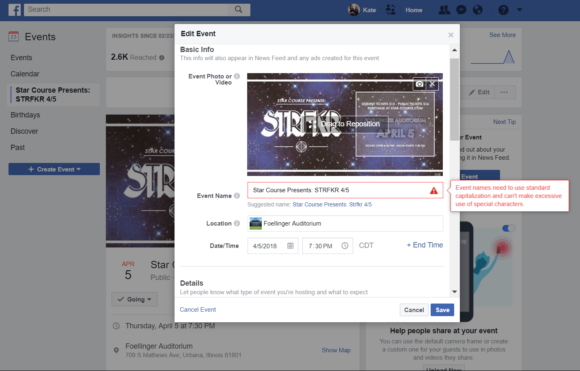
For Star Course we make Facebook events and run online promotions for our upcoming concerts, which means I have to start spending more time on this nightmare website than I ever want to. The only thing that’ll make you hate Facebook more than scrolling through the feed is trying to use it as a marketing platform. Facebook thinks it is so smart by using algorithms to save users from spam but these actually make it harder to do the marketing that I want to do. For example Facebook doesn’t like that I’ve put STRFKR in the event title in all caps, even though it let me a create it like that in the first place?? Now I can’t edit the event details without also changing the title. After some tinkering I guess 5 or less consecutive capital letters are fine, but 6 letters crosses the line. I know that the band chose the name “STRFKR” to make marketing a pain in the ass and you know what, it actually works in ways that I don’t think they originally anticipated for it to work.
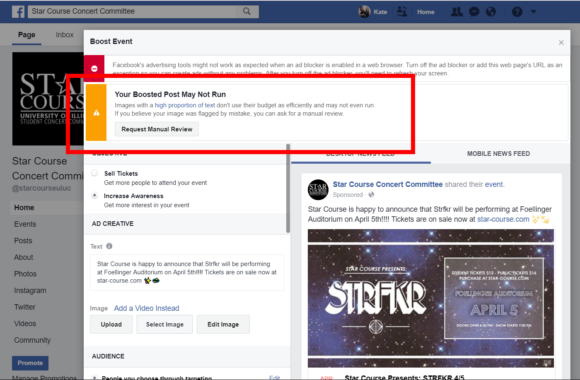
I also can’t pay to boost my own post because my cover photo has too many words, even though this hasn’t been a problem with previous posters that have the same amount of words. Whatever image processing algorithm they’re using must be able to read certain formats over others. I strongly dislike the wording of “Images with a high proportion of text don’t use their budget as efficiently and may not even run” because it implies that this is my own fault!! Why can’t you just tell me straight up what the image requirements are, and is the “high proportion of text” decided by the number of words or by a picture-to-text ratio? Why am I punished for using a poster for a concert as a cover photo for a concert event? Why is this so hard??
Project 4 Ideas
- Reputable news articles with the sources and authors removed. How reputable do these sites now become without a way to validate information?
- Remove submission button from homework submission platforms like Compass, Webassign, Moodle, etc.
- Remove a person’s messages from a group message on Messenger, GroupMe, etc. How do conversations change without you or another person?
- Remove number of streams from Spotify
- Remove followers from Instagram, Twitter, Facebook
- Remove # likes, retweets from social media posts
- Remove reviews from Amazon
- Remove “send” button from email or messaging services
Observation #5

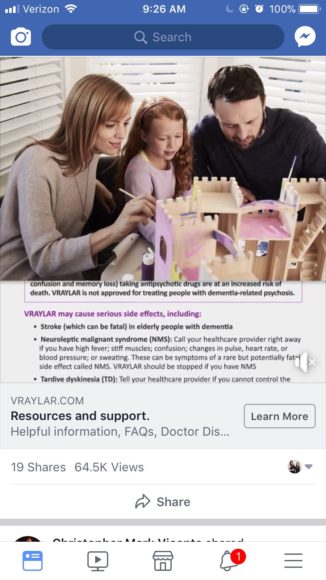
This week I learned that you can advertise for prescription medication on Facebook. I suppose this shouldn’t be entirely surprising since pharmaceutical companies advertise on television all the time, but this was the first time I noticed that these kinds of ads (including a video stream of risk information and side effects, as you can see above) were showing up on my social media feed. This made me think about the possible ethical ramifications of algorithmic-driven targeted advertising for medication. What about my internet activity makes me a viable consumer target for a certain medication? Are there certain behaviors that flag specific medical conditions and therefore a possible need for a drug? What happens when people can start making assumptions about my health conditions, accurate or otherwise? Will pushing a pharmaceutical agenda over social media put more people at risk for taking drugs that aren’t right for them or that they don’t need? Is there even a limit on what you can advertise on Facebook?
Tapermonkey first script
// ==UserScript==
// @name First Userscript
// @namespace http://tampermonkey.net/
// @version 0.1
// @description Tweak NYT a litte
// @author KateM
// @match https://www.washingtonpost.com/*
// @grant none
// @require http://code.jquery.com/jquery-latest.js
// ==/UserScript==
(function() {
'use strict';
var j = jQuery.noConflict();
// anything here will run when NYT loads
// hide, show, fadeIn, fadeOut, css, text
// append, prepend, before, after
// class selector, id selector, contains()
j('.headline').prepend('\"We heard that ');
j('.headline').append(',\" reports New York Times.');
})();
3. Add

j('h2, div.mo-info-name').prepend('Kidz Bop presents ');
j('section.content.playlist span.tracklist-name').prepend('\"');
j('section.content.playlist span.tracklist-name').append('\", covered by Kidz Bop');
j('section.content.playlist span.artists-album.ellipsis-one-line').append(", ft. Kidz Bop");

j('article h2 a, div.item-list li div.views-field.views-field-title span.field-content a').append('...we think.');

j('div.fsl.fwb.fcb a').append(', Ph.D');
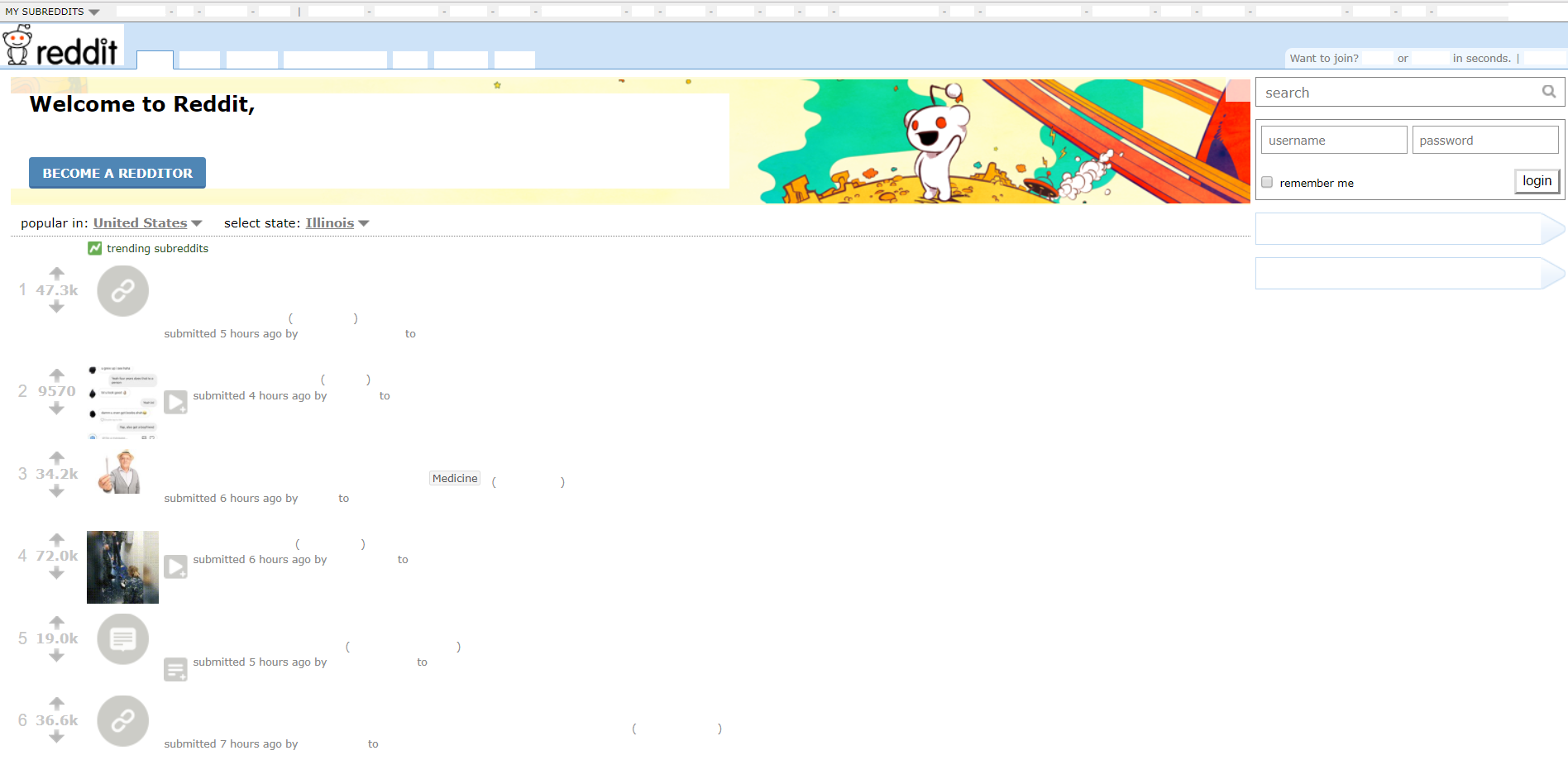
j('a').css('backgroundColor', 'white');
j('a').css('color', 'white');
Observation: Facebook Face Recognition

As I was scrolling through Facebook on my desktop this very subtle, unassuming post showed up between the normal posts on my feed. At first I skimmed right over it, but then I went back to take a closer look. Introducing new features over a colorless post on my feed vs. though an email or through the brightly colored pinned feature posts at the very top of my feed seems like an odd way for Facebook to showcase this kind of information. It made me think that Facebook is required to update me on changes to their service but they’re almost hoping for me to miss it. Their language seems intentionally worded to scare me or guilt me into not turning off this feature. “Oh don’t worry, you are totally in control of everything on this website — at Facebook, we put the user in control….buuuuuut…….here’s why you should still do what we want anyway: if you turn this off people will steal your identity, you’ll be hurting disabled people, and what if you miss out on the next cool feature??” The Learn More page gives no more information about features using facial recognition (it’s the same message but with pretty illustrations of happy people) except it includes detailed steps on how to turn it off (and makes it seem a lot more complicated then it is).
It made me start thinking about how much Facebook knows what I look like. What “features” are they using this data for that they aren’t telling me about? Who else has access to this kind of information? Why do they want to be able to identify my face so badly? I decided to turn off the facial recognition feature, and I’m interested to see if it impacts my experience using Facebook in any way.

I think it’s interesting that you can choose to see fewer informational posts from Facebook or report their own post back to them.

Three posts later this article showed up on my feed…coincidence??
2/6 JavaScript Practice
j('h3.menu-heading:contains("Arts")').css('background-color','lightblue');
j('span.mw-headline, span.mw-editsection a').css('border','2px solid green');
j('td.a-text-bold p').css('border','2px solid red');
jQuery Screenshot

j(‘p’).css(‘backgroundColor’, ‘pink’);
j(‘p:contains(“Assignment”)’).css(‘font-family’, ‘Impact, Charcoal, sans-serif’);
j(‘h2’).css(‘color’, ‘green’);
Week4 In-Class Screenshot
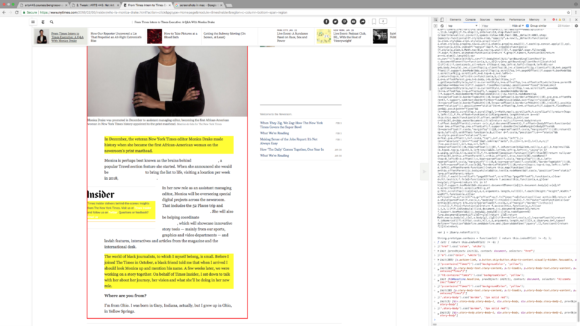
j(‘href’).css(‘color’, ‘white’);
j(‘p:contains(“Times”)’).css(‘backgroundColor’, ‘yellow’);
j(‘.story-body’).css(‘border’, ‘3px solid red’);